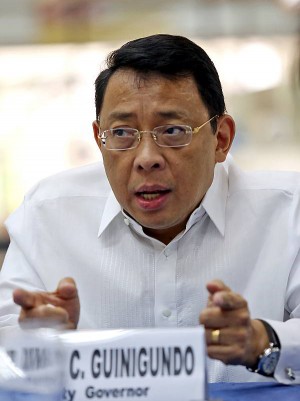
GUINIGUNDO
Achieving even the low-end of government’s growth target for this year may be a challenge in the face of a volatile peso and the negative sentiment in the equities market, a central bank official said.
The peso fell to a fresh five-year low on Monday, closing at P46.815 to the US dollar, as stocks plunged 6.7 percent after the Beijing stock market crashed.
Both the equities market and the peso rebounded yesterday, with the peso closing at P46.61 and the Philippine Stock Exchange index gaining 39.33 points to close at 6,830.34.
NO INTERVENTION
Bangko Sentral ng Pilipinas deputy governor Diwa C. Guinigundo said there is no need to intervene in the market.
The central bank occasionally intervenes to prevent excessive volatilities in the exchange rate.
“As we said during the last meeting that we had, we believe that the monetary policy remains appropriate at this point. But the BSP continues to monitor the developments,” Guinigundo told reporters at the sidelines of the awarding of Bangko Sentral’s partners yesterday.
WARNING SYSTEMS
“We will always watch out for risks even before they fall because we have early warning systems, monitoring and surveillance mechanisms, which would allow us to undertake preemptive action,” he said.
He said the devaluation of the Chinese yuan has “imposed collateral impact on the other regional currencies, including the peso.”
He said it’s challenging to tell whether the peso will continue to fall or the market will correct itself. Anything can happen before the end of the third quarter, he added.
OPTIMISTIC
Guinigundo was optimistic, however, that the country’s gross domestic product will grow at a faster rate than the 5.1 percent logged in the first quarter of this year.
“The economy is growing. Inflation is benign. The amount of liquidity in credits available are more than sufficient at this point,” he said.
“There should be no reason why the economy should not hit a higher level of economic growth than what it achieved in the first quarter of 2015,” he added.
The government has maintained a 7-8 percent growth target, but Guinigundo said “it will be a challenge to hit the lower end of the target which is 7 percent.”
He said GDP growth can be helped along by an increase in public spending, particularly for infrastructure and social services.
He also said the country should see more of the public-private partnerships that were approved.
BUFFERS
Asked if the state of the regional and global economies could usher in another financial crisis, Guinigundo said this would depend on the resiliency of the regional economies.
As for the Philippines, he said the country’s “buffers are sufficiently strong.”
The weaker peso will be favorable to exporters, business process outsourcing companies, foreign exchange bodies and the government as it will bring about larger revenues.
On the other hand, this will mean that imports will become more expensive and may bring about an increase in inflation rate. For the Philippines, which is dependent on imports, this may not bode well, Guinigundo said.